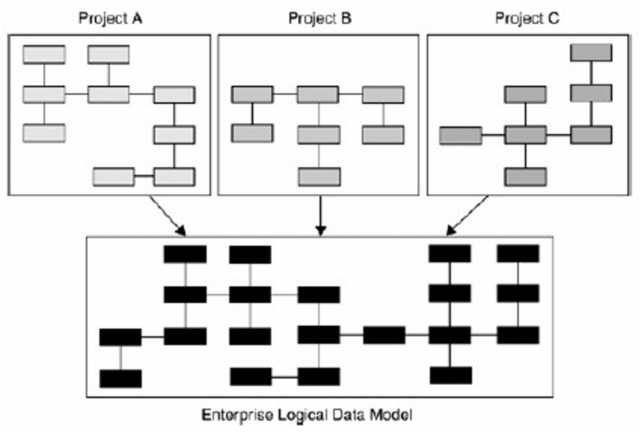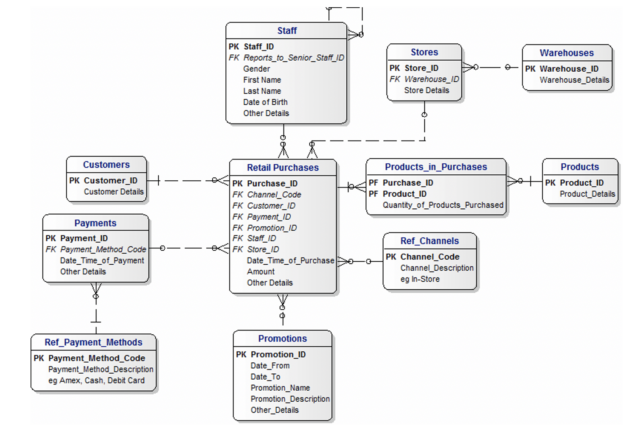Expand the enterprise logical data model
Logical data model helps to define the detailed structure of the data elements in a system and the relationship between data elements. They refine the data elements introduced by a conceptual data model and form the basis of physical data model. Usually, this process is done by the enterprise architecture group but if the organization don’t have enterprise architecture group, the data administrator can done this process. The enterprise logical data model is made from the combinations of a projects and then all of the projects will be combined as a logical data model.
The example of enterprise logical data model is on Retail area we can look the example below:
The enterprise logical data model is not constructed all at once, nor is it a prerequisite for BI Projects to have a completed one. Instead, the enterprise logical data model evolves more time and may never be completed. It does not to produce a finished model but to discover and resolve data discrepancies among different views and implementations of the same data.
Number 5: Resolve data discrepancies
Data discrepancies can be happened when we discovered the data during the data analysis and involve other business representatives from other projects. The discovery of these discrepancies should be embraced and celebrated by the BI project team, and especially by the business people, because poor-quality data can be addressed and then resolved.
Number 6: Write Data Cleansing Specifications
Data cleansing is a process of correcting and eliminate inaccurate records (if necessary) from a database. The data cleansing porpoise is to detect dirty data (data that is incorrect, irrelevant or incomplete) and modify or delete the data to ensure that a given set data is accurate and consistent with the other sets in the system. The data cleansing specifications have to follow three rules they are :
1. Technical Data Conversion Rules
It is an any time data that mapped from one system to another system, whenever traditional system conversion or for source-to-target mapping in BI applications. The key of technical data conversion rules is the data types must match with the target data elements.
2. Business Data Domain Rules
The business data domain rules must used semantics rules (meaning and interpretation). The example of data domain violation are:
– Using default values such as blank,’AA’,’0’
– Missing data values
3. Business Data Integrity Rules
The business data integrity rules is much important then the business data domain rules because it can improve information quality than are the technical data conversion rules. The business data integrity rules govern the semantic content among dependent or related data elements, as well as constraints imposed by business rules and business policy. The example of data integrity violation are:
– Business rule violation (there are two people that have same birth date and death date)
– No unique primary key in a table (a customer number can be have by multiple customer)
Sumber:
http://www.databaseanswers.org/data_models/enterprise_data_model_for_retail/index.htm
https://sparxsystems.com/enterprise_architect_user_guide/14.0/model_domains/logical_data_model.html
https://www.etltools.org/data-cleansing.html



